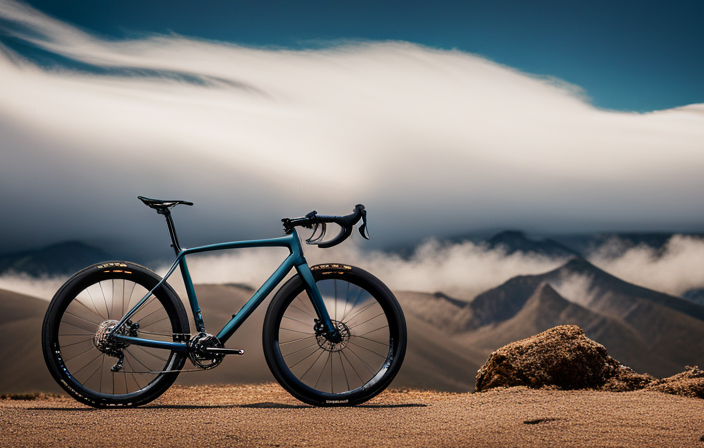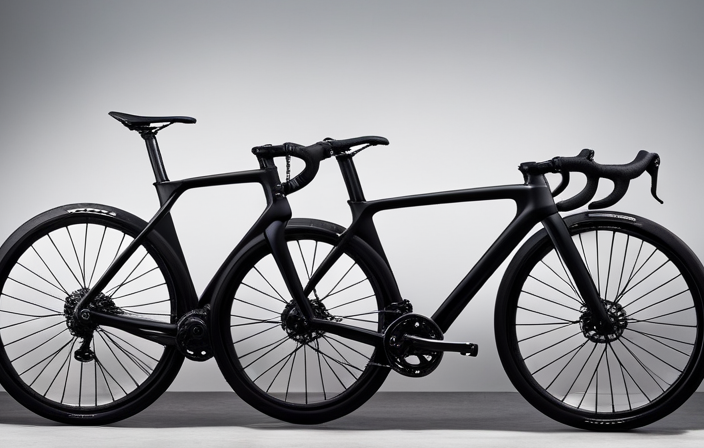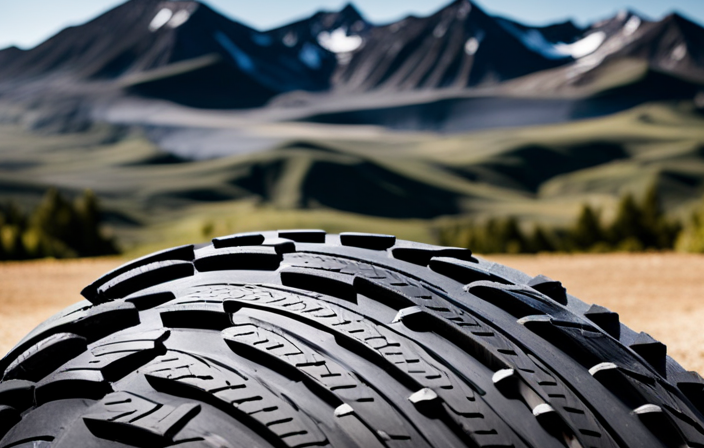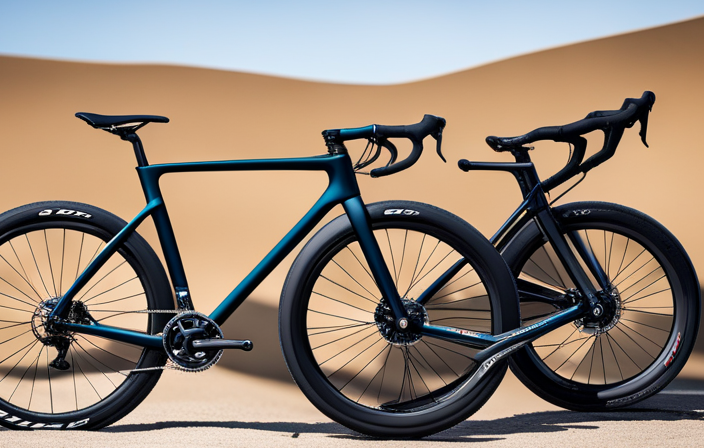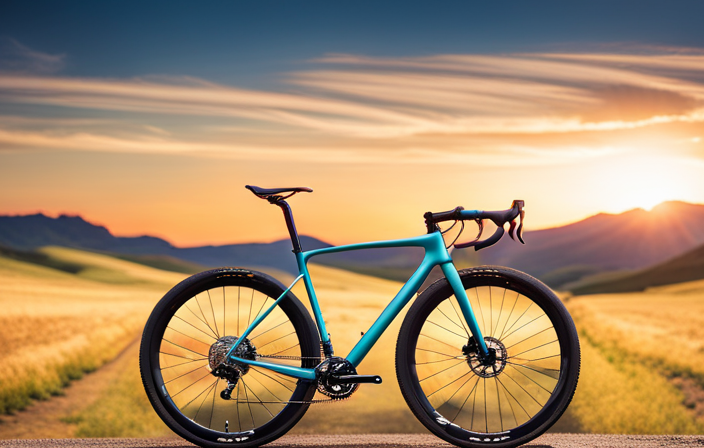Many cycling enthusiasts wonder why gravel bikes are equipped with drop bars.
In this article, we will delve into the history, anatomy, and benefits of drop bars for gravel riding. We’ll explore their geometry and fit, as well as their compatibility with bike accessories and components.
Additionally, we’ll discuss the pros and cons of using drop bars in this type of cycling and provide tips on maintenance and choosing the right drop bars for your gravel bike.
So let’s dive in and uncover the reasons behind the popularity of drop bars in this ever-growing discipline.
Key Takeaways
- Drop bars on gravel bikes provide improved handling and control on rough terrain.
- The versatility of drop bars allows for both pavement and off-road trail riding.
- Drop bars offer multiple hand positions for increased comfort over long distances.
- The aerodynamic design of drop bars enhances speed and reduces wind resistance.
The History of Drop Bars in Cycling
The history of drop bars in cycling can be traced back to the early 20th century. The evolution of handlebars in cycling has been a fascinating journey, with various designs and styles emerging over the years. However, it was the introduction of drop bars that truly revolutionized bike handling.
Drop bars are characterized by their unique shape, which features a downward curve towards the rider. This design allows for multiple hand positions, providing cyclists with greater control and stability on different terrains. With drop bars, riders can comfortably switch between an upright position for climbing hills and a lower, more aerodynamic stance for increased speed on flat roads.
The impact of drop bars on bike handling cannot be overstated. They have become synonymous with road racing bikes due to their ability to enhance performance and maneuverability. The curved shape not only reduces wind resistance but also allows for better weight distribution across the front wheel, resulting in improved cornering abilities.
Understanding the anatomy of drop bars is essential for any cyclist looking to optimize their riding experience. From the top section where hands rest during climbs to the drops where riders find themselves when descending at high speeds, each part serves a specific purpose.
By delving into the history and anatomy of drop bars, we gain valuable insights into why they have become such an integral part of gravel bikes today.
Understanding the Anatomy of Drop Bars
Understanding the anatomy of drop bars helps in comprehending why they are commonly chosen for gravel bikes. Drop bars are designed to provide multiple hand positions, allowing cyclists to customize their grip for different riding conditions. This versatility is especially beneficial for long-distance rides on rough terrain, where comfort and control are paramount.
To fully grasp the advantages of drop bars, it is essential to understand their components. The main section of the bar, known as the tops, provides a relaxed position for cruising or climbing. Moving down towards the brake hoods offers a more upright stance, ideal for navigating technical sections or maintaining control on descents. Finally, reaching the drops gives riders an aerodynamic position that maximizes speed on flat roads or during sprints.
Customizing drop bars also plays a significant role in their popularity among gravel cyclists. Riders can adjust the width of the bars to match their shoulder width or personal preference, ensuring a comfortable riding experience. Additionally, many drop bar models allow for easy installation of accessories such as lights, GPS devices, or bags.
Understanding these features and benefits sets the stage for exploring why drop bars are particularly well-suited for gravel riding and how they enhance performance in this demanding discipline without needing to take another step forward into discussing ‘the benefits of drop bars for gravel riding.’
The Benefits of Drop Bars for Gravel Riding
When it comes to gravel riding, drop bars offer multiple hand positions for comfort. This allows me to switch my grip and alleviate any discomfort or fatigue during long rides.
Additionally, drop bars provide improved aerodynamics by allowing me to get into a more streamlined position, reducing wind resistance and increasing speed.
Lastly, drop bars also offer better control and stability on rough terrain, as the lower hand position provides a more stable and responsive handling experience.
Overall, these benefits make drop bars an ideal choice for gravel riding.
Multiple Hand Positions for Comfort
Explore the multiple hand positions available on gravel bikes with drop bars to ensure your comfort during long rides. Drop bars offer a versatile range of grip options, allowing you to customize your hand position for maximum comfort and ergonomic design.
Here are four key hand positions that can enhance your riding experience:
-
The hoods: This is the most common and comfortable position, providing easy access to brakes and shifters.
-
The drops: Ideal for descending or when you need more leverage, this position lowers your body for improved control.
-
The tops: Perfect for climbing or cruising, this position offers a relaxed posture and reduces strain on your wrists.
-
The flared drops: With wider angles at the bottom of the drops, this position provides additional stability when tackling rough terrain.
By having multiple hand positions available, drop bars allow you to adapt to different riding conditions and maintain comfort throughout your gravel adventures.
Additionally, these various grip options contribute to improved aerodynamics while riding, which we’ll explore in the next section.
Improved Aerodynamics
To enhance your riding experience, you’ll notice improved aerodynamics with the various hand positions available on gravel bikes equipped with drop bars. These drop bars allow for a more streamlined riding position, which can result in improved speed and reduced wind resistance.
By placing your hands on the lower part of the drop bars, you can tuck yourself into a more aerodynamic shape, allowing you to cut through the wind with greater efficiency. This is especially beneficial when riding at higher speeds or in windy conditions.
Additionally, having multiple hand positions on drop bars allows you to adjust your body position as needed, enabling better control and stability over rough terrain.
With these improved aerodynamics and added control, gravel biking becomes an even more thrilling and enjoyable experience.
Better Control and Stability
Improve your riding experience by gaining better control and stability with the various hand positions available on gravel bikes equipped with drop bars.
Drop bars provide a wider range of grip options compared to flat handlebars, allowing you to adjust your hand placement based on the terrain and riding conditions. This contributes to improving bike handling and enhancing off-road performance.
Here are five benefits of drop bars for better control and stability:
- Multiple hand positions provide comfort during long rides.
- Lower grip position improves aerodynamics.
- Wider stance offers increased stability on rough surfaces.
- Extended reach promotes better weight distribution for improved balance.
- Ability to tuck in tight spaces provides agility in technical sections.
With these advantages, drop bars significantly enhance your control over the bike, enabling you to navigate challenging terrains more effectively.
Transitioning into the subsequent section about ‘drop bar geometry and fit,’ let’s now explore how these factors contribute to an optimized riding experience.
Drop Bar Geometry and Fit
When choosing a gravel bike, it’s important to consider the drop bar geometry and how it fits your riding style. The positioning of the drop bars has a significant impact on your body posture while riding. Drop bars are designed to encourage a more aerodynamic position, with the rider leaning forward and placing their hands lower than the saddle. This positioning helps reduce wind resistance, allowing you to ride faster and more efficiently.
In terms of fit, drop bars offer multiple hand positions that can accommodate different riding styles and terrain. The hoods provide a comfortable grip for long rides on rough surfaces, while the drops offer better control during descents or off-road sections. The ability to shift between these positions allows you to adapt your body posture based on varying conditions.
Furthermore, drop bar geometry also plays a role in handling and stability. The wider width of drop bars provides increased leverage, making it easier to maneuver through technical sections or navigate tight corners. This added control is especially beneficial when tackling unpredictable gravel roads.
Considering all these factors, the drop bar design enhances overall performance and comfort on gravel bikes. It not only improves control and stability but also offers versatility in hand positions for different terrains.
As we move into discussing compatibility with bike accessories and components…
Compatibility with Bike Accessories and Components
Looking for a gravel bike that suits your needs? Consider how compatible it is with various bike accessories and components.
One of the reasons why gravel bikes have drop bars is because they offer a wide range of compatibility with bike accessories. Drop bars provide multiple hand positions, allowing you to mount different types of accessories like lights, computers, and GPS devices easily. Additionally, drop bars are designed to accommodate various brake and shift levers, making it easier to customize your bike’s components.
When it comes to component compatibility, drop bars work well with both mechanical and electronic shifting systems. They provide ample space for brake levers and shifters, ensuring smooth gear changes and reliable braking performance. The ergonomic shape of drop bars also enhances comfort during long rides on rough terrain.
Moreover, drop bars allow for easy integration of other components such as dropper seatposts or suspension forks if needed. This compatibility ensures that you can adapt your gravel bike to suit different riding styles or preferences.
In the next section about handling and performance on different terrains, we will explore how the design of drop bars contributes to an optimal riding experience without compromising stability or control.
Handling and Performance on Different Terrains
After exploring the compatibility of gravel bikes with various accessories and components, let’s delve into another significant aspect that explains why gravel bikes have drop bars.
This involves analyzing their handling and performance on different terrains.
Gravel biking is all about versatility, tackling a wide range of surfaces from smooth pavement to rough off-road trails. To optimize handling in these diverse conditions, manufacturers conduct extensive testing using different handlebar materials.
Drop bars offer distinct advantages over flat or riser bars when it comes to maneuverability and control. The multiple hand positions they provide allow for improved stability while riding on loose gravel or tricky descents.
Furthermore, tire pressure plays a crucial role in determining the overall performance of a gravel bike. Lowering the tire pressure improves grip and traction on uneven surfaces but can compromise handling at higher speeds. With drop bars, riders can easily shift their weight forward or backward to maintain balance and control depending on the terrain they encounter.
As we transition into discussing the influence of drop bars on cycling culture, it becomes evident that these handlebars not only enhance performance but also contribute to shaping the identity of gravel biking enthusiasts worldwide.
The Influence of Drop Bars on Cycling Culture
In discussing the influence of drop bars on cycling culture, it is important to consider the traditions in road cycling. Drop bars have been a staple in road cycling for decades and are closely associated with the sport’s rich history and competitive nature.
However, there has been a recent rise in gravel cycling and adventure riding, which has led to an increased popularity of drop bars among these riders seeking versatility and comfort on different terrains.
Traditions in Road Cycling
Although traditions in road cycling have evolved over time, drop bars remain a common feature on gravel bikes. These handlebars have become synonymous with the sport and are deeply rooted in the traditions of cycling. They offer several advantages that contribute to their continued popularity:
1) Multiple hand positions: Drop bars provide cyclists with different options for hand placement, allowing them to change their grip during long rides and reduce fatigue.
2) Aerodynamics: The curved shape of drop bars allows riders to adopt a more aerodynamic position, reducing wind resistance and increasing speed.
3) Control and stability: The wider width of drop bars gives riders better control over their bike, especially when navigating rough terrain or descending at high speeds.
The rise of gravel cycling and adventure riding has further solidified the use of drop bars on gravel bikes. These handlebars provide comfort, versatility, and performance benefits that make them well-suited for tackling diverse terrains.
The Rise of Gravel Cycling and Adventure Riding
The rise of gravel cycling and adventure riding has further solidified the use of drop bars on off-road bicycles. With the growing popularity of gravel bike events and gravel bikepacking, riders are seeking a versatile and comfortable riding experience.
Drop bars offer multiple hand positions, allowing for better control and reducing fatigue during long rides on uneven terrain. These handlebars also provide a more aerodynamic position, which can be beneficial when riding at higher speeds on flat sections or descents. Additionally, drop bars offer increased stability and control while navigating technical trails or rough surfaces.
Riders who venture into the world of gravel cycling and adventure riding will find that drop bars enhance their overall riding experience in various ways.
Now let’s delve into some tips for riding with drop bars on gravel without compromising performance.
Tips for Riding with Drop Bars on Gravel
When riding with drop bars on gravel, you’ll want to keep a relaxed grip to maintain control and absorb vibrations. Gravel riding can be bumpy and unpredictable, so it’s important to find ways to make your ride more comfortable. One way to do this is by customizing your drop bars. Different bar shapes can offer varying levels of comfort and control, so it’s worth testing out a few options before settling on the one that works best for you.
To help you understand the benefits of drop bars on gravel, let me show you a comparison table:
| Bar Shape | Benefits | Drawbacks |
|---|---|---|
| Flared | Improved control | Reduced aerodynamics |
| Compact | More hand positions | Limited space for accessories |
| Ergonomic | Comfortable grip | Less traditional appearance |
As you can see, each bar shape has its own advantages and disadvantages. By experimenting with different options, you can find the perfect fit for your needs.
Now that we’ve covered some tips for riding with drop bars on gravel, let’s move on to common misconceptions about drop bars without sacrificing comfort or control.
Common Misconceptions about Drop Bars
When it comes to drop bars, there are a few common misconceptions that I’d like to address.
The first is the belief that drop bars are only for road biking. This couldn’t be further from the truth as drop bars are now commonly found on gravel bikes and even some mountain bikes for added versatility and control.
Another misconception is that drop bars are uncomfortable for long rides. While they may take some getting used to, with proper bike fit and padded handlebar tape, drop bars can provide a comfortable and efficient riding position for extended periods of time.
Drop Bars are Only for Road Biking
Although drop bars are commonly associated with road biking, they are also used on gravel bikes. This allows for a more aerodynamic riding position and better control over the bike, even on rough terrain.
Many people believe that drop bars are only suitable for smooth roads, but this is not true. Gravel bike riders can benefit from the customization options that drop bars offer. They can adjust the width and shape of the bars to suit their preferences and adapt them for off-road use. The drop position provides stability during descents, while the hoods allow for a relaxed grip when climbing or cruising on less technical sections. Additionally, the multiple hand positions provided by drop bars help reduce fatigue during long rides.
Transitioning into the next section, it’s important to address another misconception: drop bars are uncomfortable for long rides…
Drop Bars are Uncomfortable for Long Rides
Contrary to popular belief, drop bars can be comfortable for long rides. While it is true that drop bars are commonly associated with road biking, they offer several advantages when it comes to riding comfort.
The multiple hand positions provided by drop bars allow riders to change their grip and relieve pressure on their hands and wrists during lengthy rides. Additionally, the aerodynamic position achieved by resting your forearms on the drops can reduce wind resistance and fatigue.
However, if drop bars still feel uncomfortable for some riders, there are alternative handlebars available such as flat or riser bars that provide a more upright riding position. These options allow cyclists to customize their bike’s handlebars based on their own preferences and needs.
Transitioning into customizing drop bars for gravel riding, there are various adjustments that can be made to enhance off-road performance without sacrificing comfort.
Customizing Your Drop Bars for Gravel Riding
To customize your drop bars for gravel riding, you can add bar tape with extra cushioning. This will provide a more comfortable grip and reduce fatigue during long rides. When choosing drop bar tape, consider the following options:
- Gel padding: Look for bar tape that has gel padding integrated into it. This will provide additional cushioning and absorb shock from rough terrain.
- Thickness: Opt for thicker bar tape to increase comfort. Thicker tape can help dampen vibrations and provide a softer feel on bumpy surfaces.
- Texture: Consider textured or tacky bar tape for better grip in wet conditions or when wearing gloves.
- Durability: Choose a high-quality, durable bar tape that can withstand the demands of gravel riding.
- Colors and designs: Customize your bike’s appearance by selecting bar tape that matches your personal style.
By customizing your drop bars with the right tape, you’ll enhance comfort and control on gravel rides.
However, if drop bars still don’t suit your preferences, there are alternative handlebar options available for gravel riding.
Alternatives to Drop Bars for Gravel Riding
If you prefer a different handlebar style, there are alternative options available for gravel riding. While drop bars are the traditional choice for gravel bikes, flat bars can also be a great option. Flat bars provide several benefits that may suit your riding preferences and style.
One of the main advantages of flat bars is increased control and stability. The wider grip allows for better maneuverability on rough terrain, giving you more confidence when navigating technical sections or descending at high speeds. Additionally, the straighter wrist position reduces strain on your hands and wrists during long rides, promoting comfort and reducing fatigue.
Another benefit of flat bars is their versatility. They offer a wider range of hand positions compared to drop bars, allowing you to easily switch between an upright position for climbing and a more aerodynamic position for speed on flatter sections. This adaptability can enhance your overall riding experience and performance in various conditions.
While drop bars remain popular in gravel cycling, it’s important to remember that there are alternative handlebar styles available that may better suit your individual needs. Considering the benefits of flat bars such as improved control, stability, comfort, and versatility can help you make an informed decision about which handlebar style is best for your gravel adventures.
Transitioning into the subsequent section about ‘the future of drop bars in gravel cycling,’ it’s clear that riders have diverse preferences when it comes to handlebars.
The Future of Drop Bars in Gravel Cycling
Looking ahead, you might be wondering what the future holds for drop bars in gravel cycling. As the popularity of gravel riding and bikepacking continues to rise, it is clear that drop bars have played a significant role in this growth.
The influence of drop bars on bikepacking cannot be understated. Their ergonomic design provides multiple hand positions, allowing riders to stay comfortable over long distances and varied terrain. This versatility makes drop bars ideal for tackling both pavement and off-road trails.
In recent years, we have seen an explosion in the gravel cycling scene, with more and more cyclists exploring unpaved roads and seeking new adventures. As this trend continues, it is likely that drop bars will remain a staple in the gravel cycling community. However, it is also possible that new handlebar designs may emerge to cater to specific needs within this niche.
In conclusion, while the future of drop bars in gravel cycling remains uncertain, their impact on bikepacking has been undeniable. They have provided comfort and control for riders venturing into uncharted territory.
In the next section, we will explore the pros and cons of drop bars for gravel riding without writing ‘step’.
Pros and Cons of Drop Bars for Gravel Riding
You might be curious about the advantages and disadvantages of using drop bars for your gravel rides. Drop bars offer improved handling on rough terrain, allowing you to navigate through rocks, roots, and loose gravel with more precision. The lower hand position provides better control and stability, especially when descending at high speeds. Additionally, the narrower width of drop bars allows for easier maneuverability in tight spaces.
However, there are also some downsides to consider. One potential drawback is hand fatigue. The bent-forward position required by drop bars can put pressure on your hands and wrists over long distances, leading to discomfort or numbness. It’s essential to find a comfortable grip and experiment with different handlebar tape or padding options to alleviate this issue.
To create imagery in your mind, imagine yourself riding on a beautiful gravel trail with drop bars. As you cruise along the path, effortlessly navigating every twist and turn, you feel confident in your bike’s improved handling capabilities. Your hands remain steady on the narrow bars as you smoothly glide over challenging terrain.
In conclusion, while drop bars offer improved handling for gravel riding, they may also cause hand fatigue if not properly managed. Finding a comfortable grip and taking breaks when needed can help mitigate this issue. Now let’s transition into discussing maintenance and care for drop bars…
Maintenance and Care for Drop Bars
Taking proper care of your drop bars is essential to ensure their longevity and optimal performance. One advantage of drop bars is that they can be customized to suit your specific preferences and riding style. Whether you prefer a narrower or wider grip, more reach or less reach, drop bars can be adjusted to fit your needs.
It’s important to regularly inspect your drop bars for any signs of wear or damage, such as cracks or loose components. If you notice any issues, it’s best to address them promptly to prevent further damage.
To maintain your drop bars, it’s recommended to clean them regularly with a mild soap and water solution. This will help remove dirt, sweat, and grime that can accumulate over time. Additionally, lubricating the moving parts of the drop bars, such as the brake levers and shifters, will ensure smooth operation.
When customizing or making adjustments to your drop bars, it’s crucial to consult with a professional bike mechanic who has experience working with drop bar setups. They can provide valuable insights and guidance on how to achieve the desired fit and feel.
By properly maintaining and caring for your drop bars, you can maximize their lifespan and enjoy all the advantages they offer.
Now let’s move on to choosing the right drop bars for your gravel bike without delay.
Choosing the Right Drop Bars for Your Gravel Bike
When it comes to choosing the right drop bars for your gravel bike, there are a few important considerations to keep in mind.
First, you’ll want to think about the width of the bars, as this can greatly impact your comfort and control on rough terrain.
Additionally, considering the reach and drop measurements is crucial for finding a bar shape that suits your riding style and body proportions.
Lastly, don’t be afraid to test out different bar shapes and sizes to see what feels most natural and comfortable for you.
Remember, finding the perfect drop bars can make all the difference in enhancing your overall gravel biking experience.
Considerations for Width, Reach, and Drop Measurements
In terms of width, reach, and drop measurements, gravel bikes have specific considerations.
Measuring handlebar width is crucial in finding the right fit for your body and riding style. A wider bar provides better stability and control during off-road adventures, while a narrower one offers more aerodynamic advantages on smoother surfaces.
Optimizing reach and drop for comfort and performance is also important. The reach refers to the horizontal distance from the center of the handlebars to the furthest point of the drops, while the drop is the vertical distance between the tops of the bars and their lowest point. Finding the right balance ensures a comfortable riding position that allows for efficient power transfer and control.
By testing different bar shapes and sizes, you can further fine-tune your setup for maximum enjoyment on your gravel bike rides.
Testing Different Bar Shapes and Sizes
After considering the width, reach, and drop measurements for gravel bike handlebars, it’s time to move on to the next step: testing different bar shapes and sizes. This is a crucial part of finding the perfect handlebar setup that suits your riding style and preferences. By testing various options, you can determine which bar materials work best for you and explore ergonomic handlebar designs that enhance comfort and control.
During this process, it’s important to consider factors such as weight, stiffness, vibration dampening, and overall feel. Different materials like carbon fiber or aluminum can significantly impact these aspects. Additionally, exploring ergonomic designs with varying degrees of flare or sweep can provide a more natural hand position and reduce fatigue during long rides.
To make an informed decision about handlebars for your gravel bike, I recommend creating a nested bullet point list to compare the pros and cons of different materials and ergonomic designs:
-
Bar Materials:
-
Carbon Fiber
-
Pros: lightweight, excellent vibration dampening.
-
Cons: higher cost.
-
Aluminum
-
Pros: affordable option, durable.
-
Cons: less vibration absorption.
-
Ergonomic Designs:
-
Flare
-
Pros: improved control on rough terrain.
-
Cons: may limit aerodynamics on road sections.
-
Sweep
-
Pros: provides a more natural wrist angle.
-
Cons: personal preference may vary.
By carefully considering these factors and conducting thorough tests with different handlebar options, you can find the ideal setup that enhances your gravel biking experience.
Frequently Asked Questions
What is the history of drop bars in cycling and how have they evolved over time?
The evolution of drop bars in cycling has had a significant impact on performance. Originally, they were designed for road racing to allow cyclists to adopt an aerodynamic position and enhance speed. Over time, the design has evolved with different shapes and materials to improve comfort and handling.
Drop bars provide multiple hand positions for long rides, reducing fatigue. They have also become popular in gravel biking due to their versatility and ability to handle rough terrain while maintaining aero advantages on smoother sections.
Can drop bars be customized to fit different riding styles and preferences?
Yes, drop bars can be customized to fit different riding styles and preferences. There are various customization options available, such as adjusting the width, reach, and drop of the bars. This allows cyclists to achieve a more comfortable and efficient riding position.
The benefits of drop bars include improved aerodynamics, multiple hand positions for long rides, and better control during descents. By customizing drop bars, cyclists can optimize their bike setup to suit their unique needs and riding style.
Are there any misconceptions or myths surrounding drop bars for gravel riding?
Common misconceptions about drop bars for gravel riding include the belief that they are uncomfortable and limit control. However, drop bars offer numerous benefits for this type of riding.
They provide multiple hand positions, allowing riders to change their grip and reduce fatigue. Drop bars also improve aerodynamics by allowing a more streamlined position.
While it may take some time to get used to them, the versatility and advantages of drop bars make them a popular choice for gravel riding.
What are the alternatives to drop bars for gravel riding and how do they compare in terms of performance?
Alternative handlebars for gravel riding include flat bars, bullhorns, and butterfly bars.
Flat bars provide a wider grip and more control, making them suitable for technical terrain.
Bullhorns offer multiple hand positions and are popular among riders who prioritize aerodynamics.
Butterfly bars provide a variety of hand positions and are ideal for long-distance rides.
When compared to drop bars, these alternatives may offer different levels of comfort, control, and aerodynamics depending on the rider’s preferences and riding style.
How do you choose the right drop bars for your gravel bike and what factors should be considered in the selection process?
When choosing drop bars for your gravel bike, it’s important to consider the advantages they offer.
Drop bars provide multiple hand positions, allowing for better control and comfort on varied terrain.
The right size is crucial for a proper fit, ensuring optimal handling and reducing strain on your wrists and shoulders.
Factors such as reach, drop, and width should be considered based on your riding style and preferences.
Properly chosen drop bars can greatly enhance your gravel riding experience.
Conclusion
In conclusion, drop bars have become an integral part of gravel biking for a multitude of reasons.
Just like a skilled conductor guiding an orchestra, these bars orchestrate the perfect balance between control and comfort on rough terrains.
Their ergonomic design and versatile hand positions provide stability and efficiency, allowing riders to conquer any adventure with ease.
While there are pros and cons to consider, maintaining and choosing the right drop bars will ensure a seamless riding experience.
So join the gravel revolution and embrace the magic of drop bars as you explore endless possibilities on your trusty steed.
